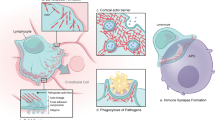Abstract
Neutrophils and other phagocytes migrate to the site of infection, ingest pathogens, and destroy them after releasing granule contents and active oxygen. These activities of the cells are closely associated with a rapid reorganization of the cytoskeleton, in which actin polymerizes, cross-links, anchors to the membrane and depolymerizes under the control of various actin-associated proteins. Defect in actin or its associated proteins results in neutrophil cytoskeletal disease where abnormality primarily appears as motility or chemotactic defect of the cells. Although their molecular mechanisms have not been elucidated, neutrophil actin dysfunction and neutrophil actin dysfunction with abnormal 47- and 89-kd proteins have been reported. Recently, abnormal—β-actin disease and disease with Rac 2 mutation, both of which accompany neutrophil chemotactic dysfunction, were analyzed at the molecular level. These diseases are systemic, but neutrophil dysfunction of the patients is remarkable. Here we review the literature on diseases due to cytoskeletal abnormality. Many other diseases with actin or actin-associated protein dysfunction may be reported in the near future.
Similar content being viewed by others
Author information
Authors and Affiliations
About this article
Cite this article
Nunoi, H., Yamazaki, T. & Kanegasaki, S. Neutrophil Cytoskeletal Disease. Int J Hematol 74, 119–124 (2001). https://doi.org/10.1007/BF02981993
Received:
Revised:
Accepted:
Published:
Issue Date:
DOI: https://doi.org/10.1007/BF02981993




